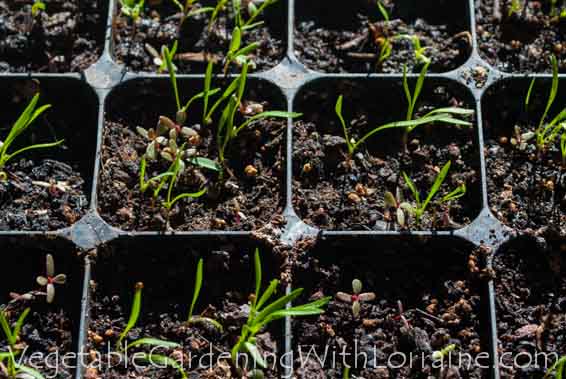- Home
- Growing Carrots
- Transplanting Carrots
Transplanting Carrots
"Transplanting carrots doesn't work". Everybody says not to transplant carrots.
Even me.
But what do you do when you work full-time, the days are in the high 90s, and the humidity is less than 10%? Transplanting may be the only way to get a crop, because otherwise you'd have to be home to mist your carrot seeds 3-4 times a day for 1-3 weeks in order to get decent germination.
 Carrot Seedlings in a Deep-Root Seed Starting Tray
Carrot Seedlings in a Deep-Root Seed Starting TrayWhat we should have done, you and I, is set our seeds down in the spring when the soil was still wet and cold from winter. But we didn't. So here's Plan B...
The difficulty with transplanting carrots is that as soon as the seed germinates, it sends down an incredibly long - for its size - taproot. By the time the cotyledons (the long “seed leaves” that first emerge) are big enough to use as a handle for transplanting, the roots are already 2-3 inches long, and it's very difficult to handle these delicate roots without damaging them.
So this year I have tried a couple of ways to start a midsummer carrot crop in my hot dry climate. Only one of them worked (the other yielded badly forked carrots, so I won't share.)
I have a basement seed starting operation that I use for growing my own starts in the spring. It consists of some sturdy wire shelving from Costco with cool-white fluorescent shop lights hanging from the shelves, illuminating the shelf below. The lights hang on little chains so I can adjust their height.
Until a couple of years ago, I had never used them for carrots.
Transplanting Carrots the Only Way I Know
That Kinda Sorta (But Not Really) Works
Start carrots in seed starting trays indoors, in good quality, finely textured and densely packed potting soil. Use seed starting trays that are at least 2” deep. Sow 2 seeds per cell. When the cotyledons emerge and get to be about ¾” long, carefully push the soil plug out of the tray and transplant the whole plug into the ground. If both carrots have germinated and survive transplanting, thin to one carrot. Or not.
Addendum 2020: a much better way is to use a soil blocker. Plant your carrots in the soil blocks, and as soon as they germinate get those puppies in the ground.
It’s important that the soil stays packed together as you transplant, or the roots will be damaged. If this happens, your adult carrots will be forked, sometimes into 4 or 5 small stunted fingers resembling a hand.
Help share the skills and spread the joy
of organic, nutrient-dense vegetable gardening, and please...
~ Like us on Facebook ~
Thank you... and have fun in your garden!
Affiliate Disclaimer
This website contains affiliate links to a few quality products I can genuinely recommend. I am here to serve you, not to sell you, and I do not write reviews for income or recommend anything I would not use myself. If you make a purchase using an affiliate link here, I may earn a commission but this will not affect your price. My participation in these programs allows me to earn money that helps support this site. If you have comments, questions or concerns about the affiliate or advertising programs, please Contact Me.Contact Us Page



